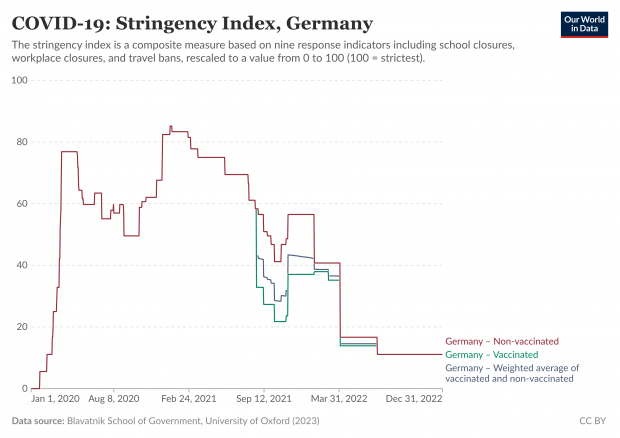Transkribiert nach einem aktuellen TikTok video der letzten Woche.
I just heard the most beautiful story about life and I needed to share it with you.
There’s two babies sitting in the womb and the first one asked the second, “Do you think there’s life after delivery?”
“Yeah, I think so. You know, I don’t really know what it’s going to be like, but it’s the next stage in our evolution and growth.”
And the first one says, “That’s total nonsense. What kind of life could be possible after delivery?”
The second one responds, “Maybe there’s even more light and maybe we can walk on our legs and eat with our mouths. We might even develop other senses that we’re not aware of now and we don’t even understand.”
The first one says, “That’s ridiculous. We can’t walk. And eating with our mouths, we have an umbilical cord that is scientifically proven to give us all of the nourishment that we need. It’s far too short to go with this after delivery. To have life after delivery has to be logically excluded.”
And the second one says, “Well, maybe it’s just different. You know, maybe we don’t need the cord. Maybe there’s other ways that we can be nourished.”
The first one jumps in and says, “All right, well, you know what? If there really is life after delivery, then how come no one’s ever come back? ” It’s a stupid thought. After delivery is nothing but darkness and silence and oblivion and nothing.”
The second one replies, “I don’t know. Maybe we’ll meet Mother and she’ll take care of us.”
“Mother,” the first one replies, “You actually believe in Mother? If Mother exists, then where is she now?”
And the second one says, “Mother is all around us. We exist in her and of her. It’s in her that we live. Without her, this world could not and would not exist. Well, I don’t see her, so it’s only logical that she’s not here.”
And the first one replies, “Sometimes in silence, you can perceive her presence. You can feel her heartbeat and you can even hear her calling from above telling you how much she loves you. And maybe, just maybe, life doesn’t end with delivery, but it actually just begins.”
Der Ursprung der Geschichte ist nicht völlig klar – soll sich bei Útmutató a Léleknek finden oder bei einem gewissen Henri J.M. Nouwen. Sehr viel wahrscheinlicher ist der Autor aber Pablo J.Luis Molinero (“Morphogeny“). Nun also meine Übertragung auf Deutsch.
Ich habe gerade eine nette Geschichte über das Leben gehört und will sie nun Dir erzählen.
Zwei ungeborene Zwillinge sitzen im Mutterleib. Da fragt der eine den anderen: „Glaubst du eigentlich, dass es ein Leben nach der Geburt gibt?“
„Ja, ich denke schon“, antwortet der zweite. „Ich weiß nicht genau, wie es sein wird, aber es ist sicher der nächste Schritt in unserer Entwicklung und unserem Wachstum.“
Der erste schüttelt den Kopf. „Das ist doch Unsinn! Wie soll denn Leben nach der Geburt überhaupt aussehen?“
Der zweite überlegt kurz und sagt dann: „Vielleicht gibt es mehr Licht. Vielleicht können wir auf unseren eigenen Beinen stehen und mit unserem Mund essen. Vielleicht entdecken wir sogar neue Sinne, von denen wir jetzt noch nichts wissen.“
Der erste lacht spöttisch. „Laufen? Essen mit dem Mund? Das ist doch absurd! Wir haben doch die Nabelschnur, wissenschaftlich bewiesen, sie gibt uns alles, was wir brauchen. Und die ist viel zu kurz, um uns nach der Geburt weiter zu versorgen. Nein, ein Leben nach der Geburt ist schlicht und einfach ausgeschlossen.“
„Vielleicht ist es einfach anders“, entgegnet der zweite ruhig. „Vielleicht brauchen wir die Nabelschnur dann gar nicht mehr. Vielleicht gibt es eine ganz neue Art, wie wir versorgt werden.“
Der erste wird ungeduldig. „Und wenn es wirklich ein Leben nach der Geburt gibt – warum ist dann noch nie jemand zurückgekommen? Nein, nein, nach der Geburt kommt nichts. Nur Dunkelheit, Stille und das große Vergessen.“
Der zweite überlegt einen Moment und sagt dann leise: „Vielleicht begegnen wir nach der Geburt der Mutter. Vielleicht kümmert sie sich um uns.“
Der erste lacht. „Die Mutter? Du glaubst an eine Mutter? Wo soll sie denn sein?“
Der zweite antwortet: „Sie ist überall um uns herum. Wir leben in ihr und durch sie. Ohne sie könnten wir gar nicht existieren.“
Der erste bleibt skeptisch. „Aber ich sehe sie doch nicht, also gibt es sie auch nicht.“
Der zweite lächelt. „Manchmal, wenn wir ganz still sind, können wir ihre Gegenwart spüren. Wir hören ihren Herzschlag. Und vielleicht, ja vielleicht, ist die Geburt nicht das Ende – sondern erst der Anfang.“
Zu gern würde ich jetzt allerdings gern auch noch das Original lesen.
CC-BY-NC Science Surf
accessed 28.11.2025






